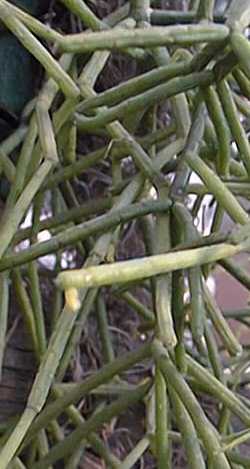Mistletoe Cactus
Scientific Name: Rhipsalis baccifera (J.S. Mueller) Stearn
Synonym: Cactus caripensis, Cactus fasciculatus, Cactus pendulus, Cassyta baccifera, Cassytha filiformis, Hariota fasciculata, Rhipsalis baccifera ssp. fasciculata , Rhipsalis baccifera ssp. rhodocarpa , Rhipsalis bartlettii, Rhipsalis caripensis, Rhipsalis cassutha, Rhipsalis cassuthopsis, Rhipsalis cassytha var. rhodocarpa , Rhipsalis cassytha, Rhipsalis cassythoides, Rhipsalis dichotoma, Rhipsalis fasciculata, Rhipsalis heptagona, Rhipsalis hookeriana, Rhipsalis hylaea, Rhipsalis madagascariensis, Rhipsalis minutiflora, Rhipsalis neocassutha, Rhipsalis parasitica, Rhipsalis parasitica, Rhipsalis pilosa, Rhipsalis suarensis, Rhipsalis suareziana, Rhipsalis undulata
Family: Cactaceae
USDA: 9b-10
Frost Tolerance: Semi tender, needs protection on coldest nights
Sun Exposure: Light shade to shade
Origin: Florida, Mexico to Brazil
Growth Habits: Hanging epiphytic cactus, stems to 6 feet long (1.8 m)
Watering Needs: Water freely in spring and summer
Propagation: Cuttings, seeds

Grow Rhipsalis in a porous soil, to which you have added peat or sterile leaf mold. Fertilize occasionally. Water abundantly during the growing season, and particularly when the plant is blooming.
The species name "baccifera" comes from the Latin for "bearing berries".
Propagation:
Cuttings root in 2 to 6 weeks depending on the season
Links:
Rhipsalis
Desert-Tropicals is dedicated to provide gardening advice, gardening ideas, and information about flower of all kind for landscape and collections.We try to check carefully the identification of the plants on the illustrations as well as the other information from the page, but occasionally errors do occur. if you notice anything that needs to be changed please contact us.Thanks.
© 1998-2020 Philippe Faucon, All Rights Reserved.
